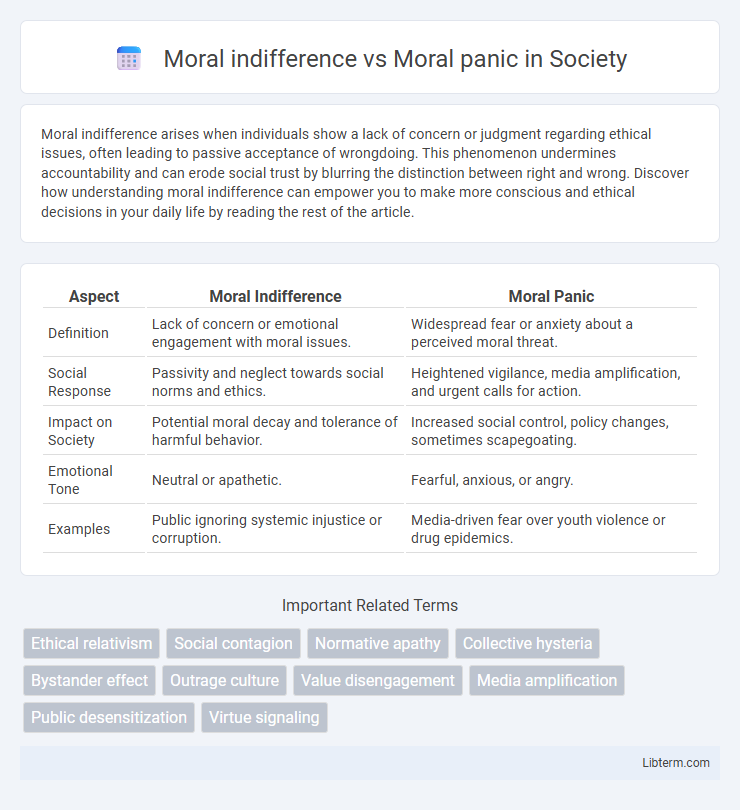Moral indifference arises when individuals show a lack of concern or judgment regarding ethical issues, often leading to passive acceptance of wrongdoing. This phenomenon undermines accountability and can erode social trust by blurring the distinction between right and wrong. Discover how understanding moral indifference can empower you to make more conscious and ethical decisions in your daily life by reading the rest of the article.
Table of Comparison
| Aspect | Moral Indifference | Moral Panic |
|---|---|---|
| Definition | Lack of concern or emotional engagement with moral issues. | Widespread fear or anxiety about a perceived moral threat. |
| Social Response | Passivity and neglect towards social norms and ethics. | Heightened vigilance, media amplification, and urgent calls for action. |
| Impact on Society | Potential moral decay and tolerance of harmful behavior. | Increased social control, policy changes, sometimes scapegoating. |
| Emotional Tone | Neutral or apathetic. | Fearful, anxious, or angry. |
| Examples | Public ignoring systemic injustice or corruption. | Media-driven fear over youth violence or drug epidemics. |
Understanding Moral Indifference and Moral Panic
Moral indifference occurs when individuals or societies show a lack of concern or emotional response toward ethical issues, often leading to apathy and inaction in addressing injustice or harmful behavior. In contrast, moral panic involves heightened emotional reactions and widespread fear about perceived threats to societal norms, frequently amplified by media and public discourse. Understanding these phenomena is crucial for analyzing social responses to controversial topics and managing collective behavior effectively.
Historical Contexts of Moral Responses
Moral indifference refers to the lack of concern or emotional response to social issues, often observed during periods of political stability or societal complacency, such as in pre-World War II Europe when widespread indifference allowed authoritarian regimes to rise. Moral panic, conversely, emerges in response to perceived threats to social order, exemplified by the Red Scare in 1950s America, where fear of communism led to intense public anxiety and policy overreach. Historical contexts shape these moral responses by influencing public awareness, media framing, and political agendas that either suppress or amplify collective concern.
Key Drivers Behind Moral Indifference
Moral indifference arises primarily from desensitization to social issues and a lack of empathetic engagement, often fueled by media saturation and information overload. Key drivers include psychological distancing, where individuals perceive moral problems as remote or irrelevant to their lives, and cognitive biases that minimize perceived threats or harms. Societal fragmentation and reduced communal responsibility also diminish collective moral urgency, contrasting sharply with the heightened emotional reactivity seen in moral panic.
Catalysts and Triggers of Moral Panic
Moral panic arises from catalysts such as media amplification, influential political rhetoric, and social uncertainty, which collectively heighten public fear and anxiety about perceived threats to societal norms. Triggers often include sensationalized incidents, crimes involving minority groups, or rapid social changes challenging traditional values. Unlike moral indifference, where societal issues are ignored or downplayed, moral panic intensifies emotional responses and prompts collective action based on exaggerated concerns.
Social and Psychological Impacts
Moral indifference can lead to social apathy, weakening community bonds and reducing collective responsibility, which often results in increased antisocial behavior and diminished trust in institutions. Moral panic triggers heightened emotional responses, causing stigmatization of targeted groups, social polarization, and sometimes irrational policy decisions fueled by fear rather than evidence. Both phenomena significantly influence societal cohesion and individual psychological well-being by shaping perceptions of safety, justice, and social norms.
Media Influence: Amplifying Panic, Sustaining Indifference
Media influence plays a crucial role in amplifying moral panic by sensationalizing events and framing issues as urgent threats, thereby intensifying public fear and anxiety. Conversely, media can sustain moral indifference through selective coverage or normalization of certain behaviors, leading audiences to overlook or accept problematic actions without critical examination. This dual role underscores the media's power in shaping societal responses, either escalating collective concern or fostering complacency.
Case Studies: Moral Indifference vs Moral Panic in Action
Case studies highlight how moral indifference often leads to societal neglect of critical issues, such as public health crises where lack of empathy delays interventions. In contrast, moral panic can amplify fears disproportionally, exemplified by media-driven reactions to youth subcultures or drug epidemics that result in policy overreach. These contrasting responses underscore the importance of balanced social perceptions to effectively address real threats without succumbing to hysteria or apathy.
Consequences for Policy and Society
Moral indifference often results in policy stagnation and social fragmentation, as a lack of collective urgency delays response to critical ethical issues, exacerbating social inequalities and undermining trust in governance. Moral panic, however, can trigger reactionary policies that prioritize short-term control over long-term solutions, often leading to the marginalization of vulnerable groups and the distortion of public discourse. Both phenomena shape societal norms and legislative agendas by influencing public perception and political will, ultimately affecting social cohesion and justice.
Strategies to Balance Moral Reactions
Effective strategies to balance moral reactions involve promoting critical thinking and media literacy to discern between justified moral concerns and exaggerated responses characteristic of moral panic. Implementing community dialogues and stakeholder engagement helps in addressing underlying issues without amplifying fear or indifference. Policy frameworks that encourage evidence-based decision-making reduce the risk of impulsive reactions driven by moral indifference or panic.
Moving Forward: Encouraging Moral Awareness
Moral indifference, characterized by apathy toward ethical issues, contrasts sharply with moral panic, which involves exaggerated societal fear and reaction to perceived threats. Moving forward requires fostering moral awareness through education that emphasizes empathy, critical thinking, and ethical reflection to balance emotional responses and promote informed decision-making. Encouraging open dialogue and community engagement helps individuals recognize ethical complexities and resist extremes of indifference or panic.
Moral indifference Infographic

 libterm.com
libterm.com